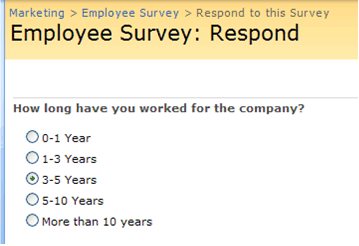Use discussions or surveys to gather input
Note: This article has done its job, and will be retiring soon. To prevent "Page not found" woes, we're removing links we know about. If you've created links to this page, please remove them, and together we'll keep the web connected.
Discussions and surveys are two ways to gather input from others.
Discussions are organized by topic. Anyone can post a message to a discussion, and multiple people can respond in a free-form manner. Surveys are presented as sets of questions, and answers are collected and organized.
Note: This article refers to an example SharePoint site created by Adventure Works, a fictitious company that manufactures bicycles, bicycle components, and bicycling accessories.
For example, the members of the Marketing team at Adventure Works use discussions to informally discuss projects or even logistics, such as sharing rides to events. The managers of the Marketing team use a survey to collect feedback from employees about team processes and team morale.
Participating in discussion boards
On a Microsoft Office SharePoint Server 2007 site, a discussion board is a place where team members can discuss topics and brainstorm with each other. A discussion board is set up similar to a newsgroup in which any participant can post a message, and multiple people can reply to it.
The discussion board shows the most recent discussion first, as well as the number of replies for each discussion. This way, you can quickly see which discussions have the most recent activity and which ones are the most popular. Members can also customize their own views of the discussion board.
To see the replies to a discussion topic, click the title of the topic.

When you create a discussion item or reply to an existing discussion, you can format your text, insert a hyperlink or table, and link to a picture on the Web.
By default, people in the Members group can participate in a discussion in the following ways:
-
Create a new item for discussion Create and edit a new discussion item by clicking a few buttons and entering text.
-
Reply to discussion posts Reply to a discussion, as well as edit your reply.
-
Participate by using e-mail If your discussion board is set up to receive e-mail, you can add discussion topics by sending an e-mail message. You create a message as you normally do, and then include the name of the discussion board on the To or Cc line of the message. Your administrator and site owner must first set up the incoming e-mail service.
-
Change the views Change how you view a discussion by sorting and filtering according to your own preferences.
-
Receive alerts of additions and changes Receive e-mail alerts that notify you when someone adds or changes an item on the discussion board.
Creating and responding to surveys
Surveys enable you to present specific questions and collect the answers in an organized format, similar to a poll. You can create several types of questions, such as multiple choice, fill-in, and ratings.
Depending on how a survey is set up, you may be able to respond to that survey only once. If you cannot finish answering every question in a survey during one session — for example, if you are interrupted while answering the questions — you can save a partial response and then finish it later. This saves your answers and closes the survey.

If you are the person creating the survey, you can add branching logic so that the survey changes according to the responses to specific questions. In a survey that branches, questions appear only if they apply to someone's situation. If the questions don't apply, the person skips that set of questions or is offered a different set of questions.
After people respond to the survey, you will want to see the results, including any patterns in the results. Surveys provide a graphical review of responses, similar to a chart, or you can export your results to another program, such as Microsoft Office Excel 2007.
To make the survey most effective, do the following when you design the survey:
-
Create questions that provoke readers to think of the needs that they most want addressed.
-
Provide an easy way for readers to effectively answer the questions.
-
Use a question-and-answer format that makes it easy to generate a measurable summary of the results from all respondents.
-
Avoid combining too many thoughts into one question, so that you can measure each response separately.
No comments:
Post a Comment